Malcom Forbes, the publisher of Forbes Magazine once said, “Diversity: the art of thinking independently together.” This quote gives us a very strong message that diversity in ideas and opinions can work for the benefit of the society at large. So, when we talk about diversity in open source, we get to see a similar scenario, where people are encouraged regardless of their gender, race, age, class or nationality to express their ideas, innovations and skill sets in a single platform to enhance better performance and results in their respective careers.
Here, I would like to draw your attention towards some of the insights of this vast topic i.e. diversity in open source. With the help of this article, I would like to give you an idea about the community contribution towards open source followed by the various challenges encountered by the community in building a platform welcoming diversity.
Let’s begin by discussing the important role of community in open source.
Power of Community in Open Source
Open source gives you the opportunity to bring up your unique ideas and innovations independently in front of the whole world. You get full freedom to share your skills regardless of ethnicity, socioeconomic status, exceptionalities or geographical area and so on. In this manner, the open-source community is built up by the contributions made by people from every nook and corner of the world. Here, we will have to understand the fact that community can be regarded as the backbone of open source. With the help of the community, one can strengthen the open source ecosystem by active participation and contribution.
Now, let us get a better understanding about the open source community with the help of a contributor funnel created by @MikeMcQuaid below:
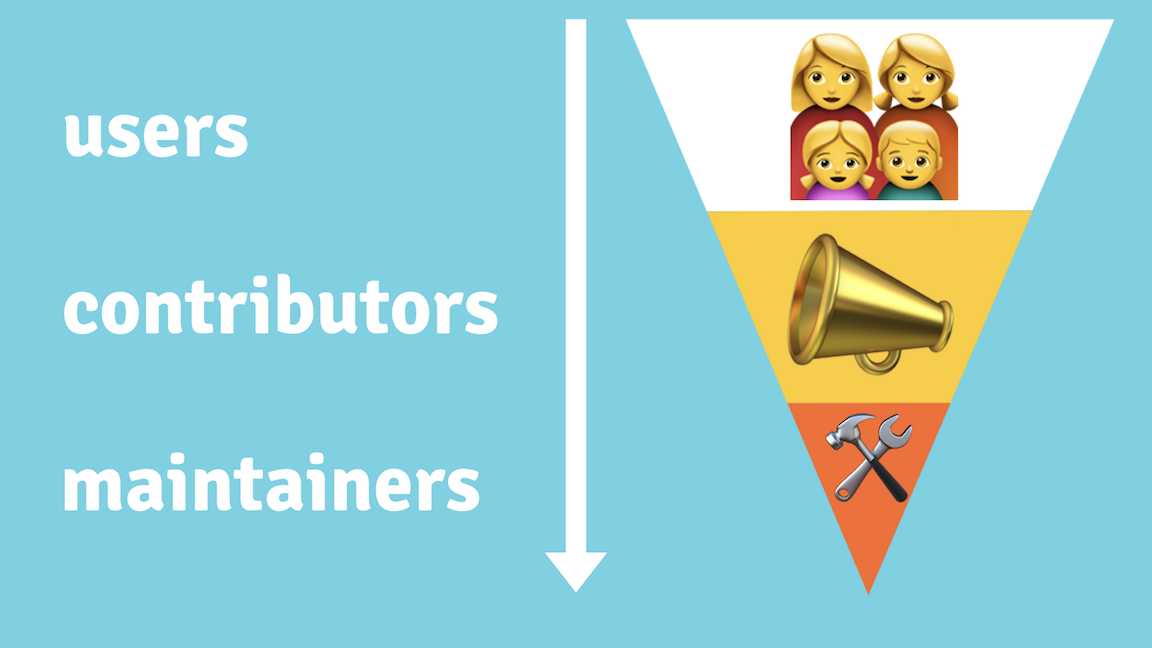
The above diagram shows three categories of participants in the open source community. Like the users, contributors and maintainers. These participants play an important role in the progress of the open source community. You will be surprised to know that every user can become a potential maintainer. It is possible by making the experience of each stage of the category easy and hassle free which indeed will encourage every user to take more responsibility and become an active maintainer of the community.
Here, the question which now comes is, how can you maintain a healthy community? Let me give you an idea of how you possibly can build up a trust-worthy community which will contribute with best endeavour. So, the first and foremost thing to do is, welcome the participants and make them feel valued in the community. After they step in, give them clarity about your work with the help of a README which will provide them full transparency regarding your project. As documenting everything about your project with a README is always a must for better understanding which is also supported by GitHub’s 2017 Open Source Survey. Thereafter, you can let the participants start their contributions by handling simple issues which will boost up their confidence and help them get more involved at work. This further gives you a chance to share the ownership of your project with them making them feel more accepted in the community. While doing that if anyone comes up with any queries, you should always be ready to answer them at the earliest.
Your community can be a great place for the contributors to learn from each other’s experiences and expertise. Therefore, it is your responsibility to expand your community by sustaining the right people and letting go of the ones who unnecessarily create a toxic environment for everyone. You should stand strong for your community giving equal value to everyone’s opinion and ideas. In this way, you can build a prosperous and healthy community for all.
What’s next? Let’s now take a look at some of the tweets supporting community contributions to open source.
Contributing to open source is easier for some than others. There’s a lot of fear of being yelled at for not doing something right or just not fitting in. (…) By giving contributors a place to contribute with very low technical proficiency (documentation, web content markdown, etc) you can greatly reduce those concerns. — @mikeal, “Growing a contributor base in modern open source”
The truth is that having a supportive community is key. I’d never be able to do this work without the help of my colleagues, friendly internet strangers, and chatty IRC channels. (…) Don’t settle for less. Don’t settle for assholes. — @okdistribute, “How to Run a FOSS Project”
While it’s important to create a sense of belonging for the members of an open source community, it is equally important to encourage diverse minds to be a part of the community and become more and more inclusive. Let’s look at a research report conducted by the World Economic Forum that highlighted the importance of diversity and inclusion at workplace. This report explains that when all the employees, managers and the entire organization work under well managed diverse teams, they tend to perform better than homogeneous teams in terms of their usual productivity. Therefore, the practice of diversity, equity and inclusion should be encouraged by the open source community too. This can be seen in the below diagram:
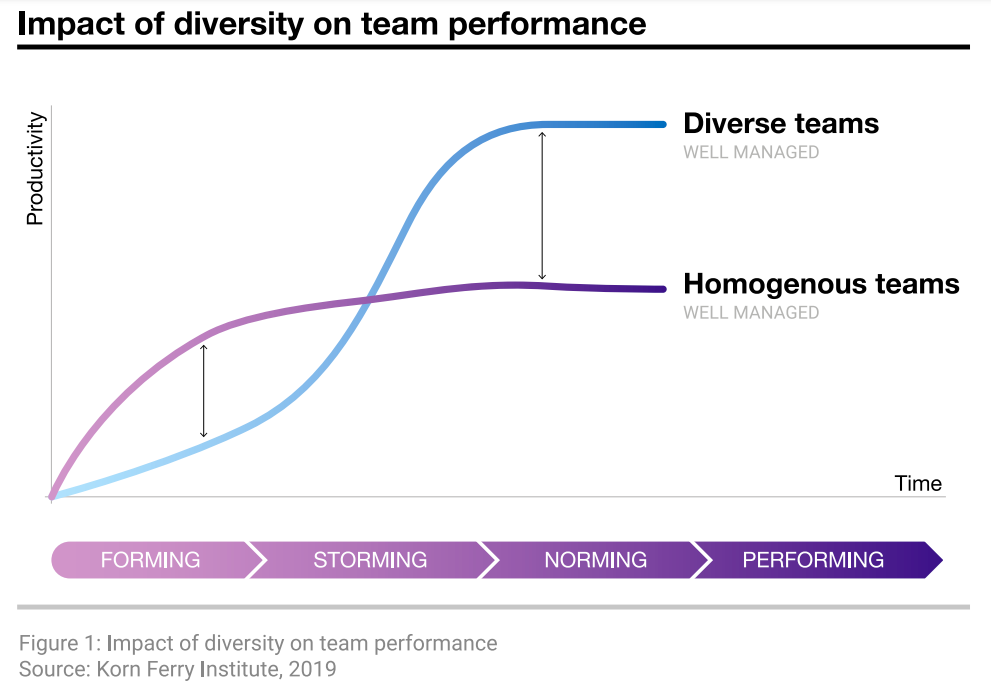
Challenges while Promoting Diversity, Equity and Inclusion in Open Source Communities
In the past few years, the open source community has witnessed some challenges while promoting diversity, equity and inclusion. Let us discuss today some of the most important challenges by taking help of some genuine survey reports.
Not enough contributions from female and non-binary coders
According to a 2017 GitHub open source survey, 95% of contributors of open source projects were male, whereas only 3% of contributors were reported to be female(1% defined as non-binary). The US Bureau of Labor Data says that only 21.2% of professional developers are female.
Here comes a diagram from 2019 DigitalOcean developer survey to show that the participation of male in open source is comparatively more than female:
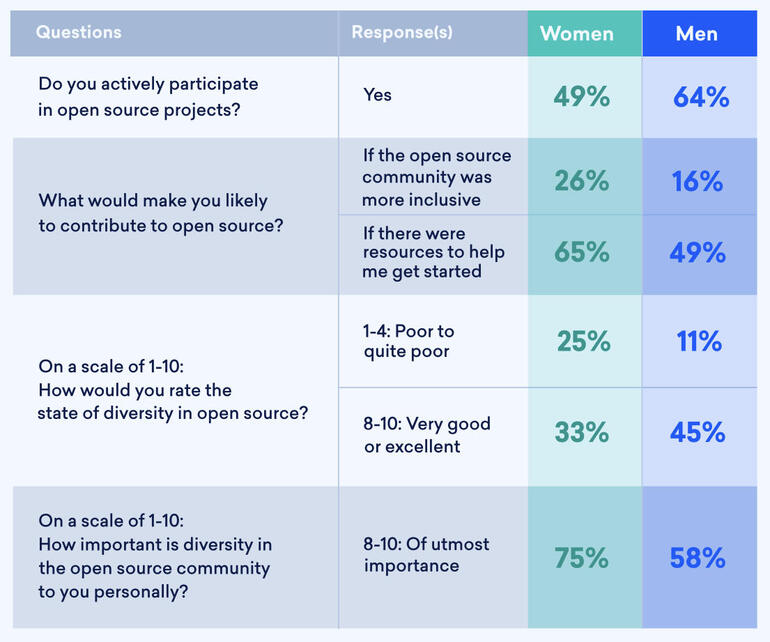
Next, let’s look at another diagram where the participation of young developers, both male and female are shown in comparison to older generations of contributors regarding their experience in open-source.

From the above diagram we can understand the fact that when the younger generation both male and female join the open-source community, they don’t find any hurdles in terms of guidance or required resources. But as we know that the older generation of contributors mainly comprises of male due to gender diversity. So, they do not preferably contribute to the change needed in the community towards gender inequality. As a result, the young female contributors experience injustice and are deprived of opportunities. Therefore, the cycle of male preference in open-source continues.
The sad state of women in a male-dominated world
To get a deeper understanding about the reasons for lack of diversity in open source, let us look into another seminar paper which was written as a part of the lecture Free and Open Technologies, held by Christoph Derndorfer and Lukas F. Lang at TU Wien, Austria, during the winter term 2019/2020. This seminar paper talks about a case, Katie Bouman.
In April 2019, the first visualization of the black hole was revealed. After this, another picture went viral which was of a young female computer scientist, named Katie Bouman. She is a postdoctoral fellow at MIT and a member of the team running Event Horizon Telescope, contributing with her algorithm to capture this image. Her team consisted of 200 researchers. But solely, Bouman was made the face of the black hole project by the media. Bouman tried to clarify this confusion but was made a role model as she was a woman working in a men-dominated field. On the other side she received immense hatred and even her Wikipedia page was said to be deleted. So, with this case you get an idea about the diversity problem in open-source.
Women need to be empowered within open source communities
Then we have one more report named “Towards a More Gender-inclusive Open Source Community” published by the Institute of Development Studies at the (DIAL) Digital Impact Alliance. It brings light into the circumstances of gender diversity. This paper shows how women can be supported and an inclusive community can be built.
This report says that there has to be some changes in facilities for women to empower them to contribute actively in open-source. Let us see how can it be done:
- Resources: In order to excel in one’s career aspirations, one should be given the right amount of resources which can be used to reach the desired goals. Similarly, talking about women in open source, they should also be provided with the opportunity of learning various skills required to enhance their knowledge and contributions. They should be given a friendly working atmosphere to come up with their ideas and plans in the community.
- Institutions: This comprises the different social environment one gets in life in the form of family, educational institutions and the society at large. It is usually seen that a woman is less likely to get the necessary support from her family in terms of education and other facilities. Growing up when they want to pursue their career and also look after their family life, they are stopped from doing so and are left to take tough decisions of choosing one over another. Therefore, a change in the society’s perception is needed to encourage women to manage their both family and career with dignity and respect.
- Agency: This comprises the ability of a woman to become a good leader and a decision maker. When it comes to open source, there is less encouragement towards women to prove their capabilities compared to men. So, such injustice has to be abolished for equal and fair chances.
As a part of the above mentioned report, one interview was conducted among women who were contributors working as programmers and multi-taskers. It’s definitely high to empower and encourage more women to participate in open source ecosystem going by the number of women who were in the open source projects at the time of interview.

Time, money, and recruitment from demographically homogeneous communities are obstacles too
In a report by GitHub, in association with The Case Foundation, Nadia Eghbal states that one of the reasons why there is a lack of diversity in the open-source community compared to the technology sector, is because the open-source contributors need time and money to contribute initially which at times can be very difficult. The open source ecosystem must be enhanced by the inclusion of diversity, believes Lorena Mesa, an engineer at GitHub and the Director and Vice-Chair Elect of the Python Software Foundation. Justin W. Flory, a member of the RIT LibreCorps and UNICEF, an open source initiative said that the early leaders of OSS recruited contributors from homogeneous communities leading to diversity issues which can be seen till the present. He further stated, “I look at what we're going through now in this emergency of emphasis on communities, on diversity inclusion, and I feel like there is no other way to describe it then as a feminist movement in free software.” Learn how good leadership and inclusion within the open source communities can make a world of difference.
Neverending myths about open source have to vanish
Now, a contribution is made by Nithya A. Ruff, the Head of Comcast’s Open Source Program Office about some misconceptions which people have about open-source. So, here it goes. The first misconception is that you need to be a programmer in order to join the open source community. But it isn’t true. Open-source is also a platform for various other industries other than technology. The second myth is that the culture and norms of the open source community is easy to navigate. But in reality it isn’t so. You will find a lot of feedback where the new contributors reveal that they don’t get the necessary co-operations from the community members. The third misunderstanding is about the fact that you can’t be a casual contributor but you rather have to work under an open-source project for your entire life-time. But the truth is, you can work according to your convenience and be a short time contributor.
Here are few tweets supporting the above discussions:


So, the above myths can also be termed as challenges towards a more diverse open-source community. Therefore, necessary steps should be taken to overcome these adversities.
Open source meritocracy and the significance of diversity and inclusion
Now let’s also look into some of the information depicting the truth about inequality and favouritism within the open-source community. Women were seen compromising their health when in the year 2015, a heart transplant was available to only 20% of women compared to 80% of men. Apple launched its first Health Tracking App in 2014 which omitted a woman’s menstrual cycle that should have been one of the major concerns regarding a woman’s health and wellness. Amazon was seen removing its AI recruiting tool which was designed to select applicants based on resumes submitted to the company over a 10 years time period that mostly came from men.
So, apart from the above mentioned challenges of diversity in open-source, you will find many other such discriminations based on socioeconomic status, nationality and so on. In cases like this a question comes to my mind, what if meritocracy was practiced in open source? It could help the community in finding the right participants with merit, intelligence, creativity and skills who were truly deserving. With meritocracy, the open-source could experience diversity, equity and inclusion within the community. This ideology is also supported by huge companies like Google, Facebook, Microsoft and Netflix. More on the impact of large companies on open source here.
Meritocracy does not consider the reality that tech does not operate on a level playing field. — Emma Erwin and Larissa Shapiro, Mozilla.
Statistics show that 78% of companies run all of their businesses with open source software. So, looking at the ratio, it is a must that all the companies working in open source software should follow the rules and regulations and include contributors encouraging meritocracy within their community. If not all, but some are taking initiatives in giving opportunities to the people around the globe looking forward to being a part of open-source. Here is an example: Outreachy is a program which organises a three month paid internship with free and open source software projects for people who experience favouritism and are under-represented in the technical industry where they are living.
After discussing the challenges of the open source community, let’s now peep into the topic, ‘Code of Conduct’ which cannot be avoided.
Is Code of Conduct Enhancing Diversity in Open Source?
Code of conduct can be a medium of communication among the contributors of the open source community. It helps people to know about the set rules, regulations and practices that are to be followed in order to maintain the professional conduct of an organization.
For open source projects, The Contributor Covenant was created by Coraline Ada Ehmke who is a software developer and an open-source advocate. This contributor covenant works for safeguarding the rights of the members of the community from experiencing misbehaviour and ill treatment. So, it is followed by prominent companies like Apple, Google, Salesforce, Linux, Creative Commons and many open-source projects as well. It has become an essential part of the open source community. We have with us an example where Eric S. Raymond, one of the founders of the Open Source Initiative was banned for violating the code of conduct by his misbehaviour. But alone CoC can’t stop discrimination happening in the field of diversity in open source. There is a need for better authority and management which can strictly look after the matter.
Wonderful Stories from Open Source Communities Embracing Diversity
The Open source community can be termed as a social movement which is diverse. It is a community model which is designed to help aspiring people contribute to the world their ideas, innovations and unique talents. Here we have some examples of extraordinary open source contributors:
1. Drupal
Diversity, Equity and Inclusion are valued by Drupal as there is a separate team to monitor their active participation and implementation. Drupal celebrates the pride month every year by changing its logo on social media platforms. This is observed inorder to thank the members of Drupal for welcoming and supporting LGBTQ+ into their community.
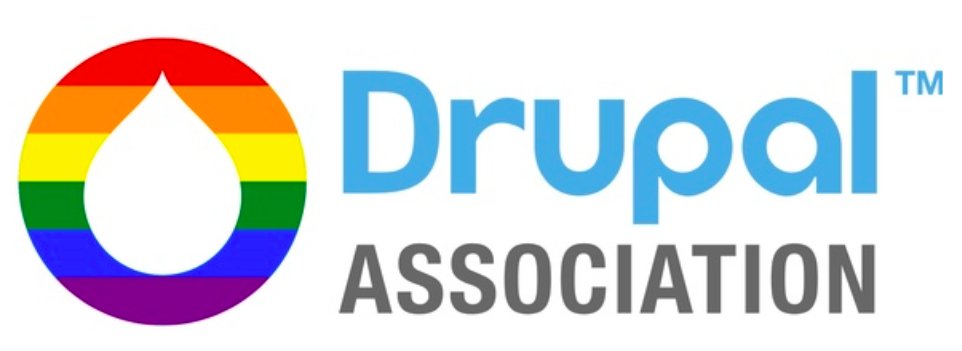
When the world was once again reminded, through the George Floyd incident, that the 21st century still witnesses the violent incidents of racism, the Drupal Community joined hands in raising its voice against such brutal attacks. The statement given by Drupal is as follows:
(We stand with people across the globe in condemning racism, racist behavior and all abuses of power. We grieve for the black community, which has endured another unspeakable tragedy in a long history of injustice)
Drupal believes in the ideology of getting better quality results or performance out of diverse working groups in the community. The Drupal Diversity and Inclusion Contribution Team aims at increasing the contributions to the Drupal projects by the people who are underrepresented or devalued in the Drupal community.

The diversity problem was handled by Drupal in a very smart way, by introducing Drupal conferences and workshops. These platforms gave exposure to the underrepresented groups to speak and open up their views, perceptions and ideas to a larger audience increasing their confidence level. A speaker training workshop was hosted on September 21 and 28, 2019 with Jill Binder by the Drupal Diversity and Inclusion Group to inspire people around the world.
The Community Working Group(CWG) also conducts workshops for the community leaders to provide them the necessary tools, resources and knowledge to build a friendly and flourishing community. To get a better idea of conducting successful conferences, CWG follows feedback from past workshops like Teamwork and Leadership workshop conducted at DrupalCon Nashville. Such workshops are of two days duration. The first day was spent by discussing the needs or necessities and challenges faced by the community members. It was followed by the discussion of utilizing the nudges appropriately and building a positive environment within the community. Then the second day, they talked about emotional intelligence and finding ways to resolve conflicts. There was also a case study challenge, where various groups were assigned tasks of resolving conflicts which were seen in Drupal or other open-source communities. These workshops proved to be beneficial for the community members.
Drupal encourages healthy conversations to maintain a positive ambience within the community. Even though people try to maintain a peaceful environment, sometimes due to differences in opinions people tend to hurt each other’s feelings. To resolve this issue, an idea was discussed at a Community Working Group (CWG) workshop at DrupalCon Seattle. For the Drupal community, the CWG Community Health team has been working on a communication initiative which comprises a series of de-escalation templates labeled as “Nudges”.
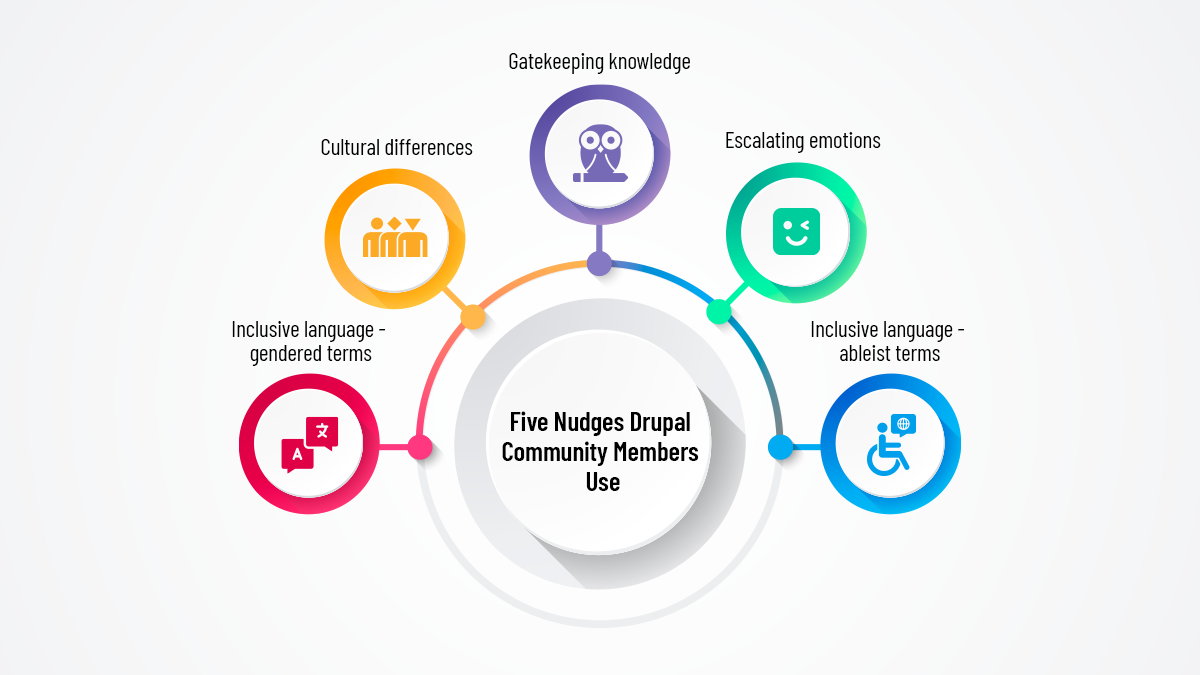
There are five nudges which the community members can utilize when they come across any such uncomfortable circumstances within the Drupal community. Every nudge gives a clarity about why a certain comment towards a member can be harmful and it also provides some relevant links like the Code of Conduct and Values and Principles.
Below are the nudges. Take a look:
- Inclusive language (gendered terms): Use of gendered language is prohibited. Such language impacts the community negatively as it encourages gender inequality within the community.
- Inclusive language (ableist terms): Use of ableist language can hurt the sentiment of people with disabilities. Therefore, one is abstained from using such language within the community.
- Gatekeeping knowledge: When a community member expects a new community member to know everything about the project without giving the required guidance and questions his/her contributions and ideas, then this nudge can be used. The new contributor shall be supported by helping them learn the necessary concept and topic.
- Cultural differences: The members coming from different backgrounds, speaking a culturally specific language are undervalued for their contribution by the other members as they are unable to speak the global language common for all. While translating one has to be very careful as expressing something exactly the same in a different language might at times sound rude and uncomfortable.
- Escalating emotions: Every community demands mutual understanding and proper communication inorder to build a healthy environment for all. So, while working together every member should be given equal amount of respect and dignity without any discrimination. The Drupal community further takes care by providing resources to the members at the time of conflict.
Give a look at what Dries Buytaert, the founder of Drupal, wants to share about gender and geographic diversity statistics of the recent years. It is as follows:
Gender Diversity’s position was closely observed by Dries Buytaert as it is one of the biggest challenges of the open-source community. A slight progress was seen in terms of contribution but still wasn’t enough to be celebrated as a victory of gender equality. Let’s take a look below:
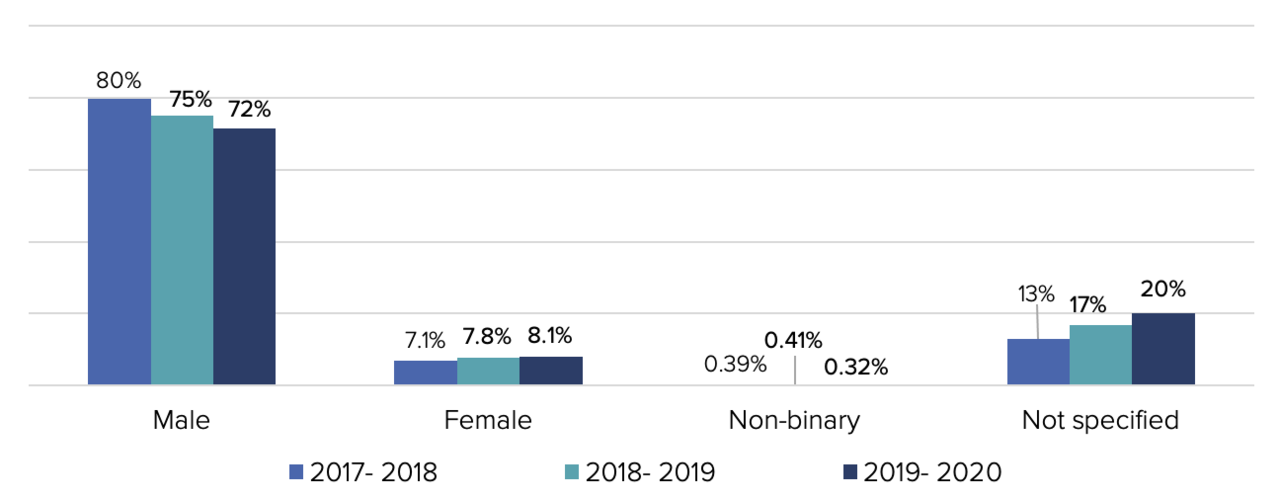
Here we have the top 20 countries from which contributions are made in Drupal. The below diagram says it all:
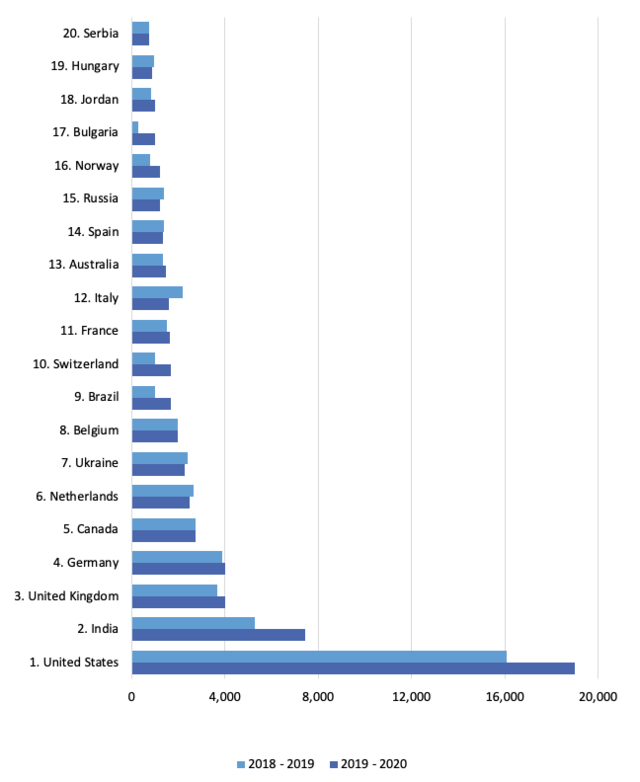
With the above explanations, we get to know that the efforts are made to improve gender and geographic diversity. But it isn’t enough. Therefore, better practices and strategies have to be made in order to reach the desired results. Learn more about Drupal's role in encouraging diversity and inclusion here.
2. Red Hat
Red Hat is one of the leading open source provider companies which actively takes initiative in building an open source community filled with innovation and productivity of better technology. They believe in the collective contribution of every skilled participant irrespective of gender, race, class or nationality within the community. One of the initiatives it took to encourage diversity was by including Women in Open Source Community Award in 2015. This ceremony was organized to appreciate and honor women for their outstanding contribution towards the open source community.
Red Hat observed a very sensitive matter of using inappropriate language by software programmers which at times affected the sentiment of some participants. The usage of terminology like ‘master’ or ‘slave’ was the major concern. Chris Wright, chief technology officer at Red Hat confirms that Red Hat is building a team to examine its documentation, code and content to find out the improper language and replace it with the right ones. Some of the changes are as follows:
- Master branch will be renamed as ‘main branch’
- Whitelist to be renamed as ‘allowlist’
- Blacklist to be changed to ‘denylist’
3. Mozilla
Mozilla is one of the communities who is open and easily accessible to everyone looking for meaningful contributions towards the vast open source community who is constantly seeking growth. Diversity has been one of the interests of this community and they have always taken the necessary steps towards it.
In 2018, the code review process was made equal for all without any gender bias by this community. To improve diversity within their staff they published a blogpost in the year 2019. Here is the progress they made:
- There was an increase of women in technical roles from 13.2 percent to 17.4 percent in their community.
- Out of all people managers, the women representation has increased from 36.0 percent to 39.1 percent and in terms of executive leadership roles, the graph has raised from 33.3 percent to 41.2 percent within December 2018.
- The representation of minorities rose from 6.9 percent to 7.9 percent in 2018, but the target of 8.9 percent couldn’t be achieved.
- From underrepresented minority groups, Mozilla hired 12.4 percent people and also a rise in people of colour from 35.2 percent (2017) to 36.2 percent (2018).
In cooperation with Kubernetes and companies like Red Hat, Mozilla gives importance to the execution of codes of conduct so that proper communication and professional conduct can be maintained within the people of diverse nature. Most importantly, it raises funds for open source projects.
4. The Linux Foundation
The Linux Foundation focuses on broadening the practice of diversity and inclusion, building a more welcoming space for people from diverse backgrounds and expertise. This association commits towards constructing a bias free environment by taking few initiatives as follows:
- Initiative of Inclusive Naming
- Advancing diversity and inclusion in Software Engineering
- Availability of free online courses
- Diversity and Inclusion in Events
- Live Mentorship Series
- LiFT Scholarships
Out of all these, advancing diversity and inclusion in Software Engineering is something that can catch one’s attention. The Linux Foundation announced the Software Developer Diversity and Inclusion (SDDI) project on 26th October 2020. Through SDDI, exploration and utilization of best research procedures, the diversity and inclusion in software engineering could be increased.
5. The Apache Software Foundation
The Apache Software Foundation started a project named Apache Diversity and Inclusion with the mission of constructing a community valuing diversity and inclusion giving exposure to a wide group of people seeking career path/ professional advancement.
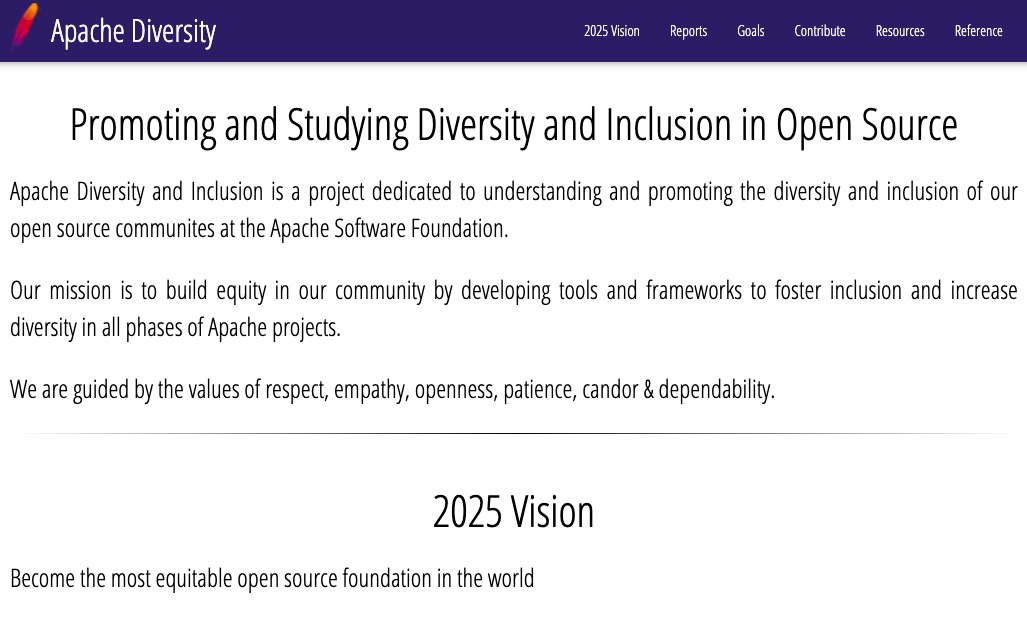
6. The Academy Software Foundation
The Academy Software Foundation stands against the injustice and inequality happening in the open-source community. It aims at removing all the barriers which creates hurdles in the process of growth and development of potential contributors all over the world.
To set your basics right and make your open source project more diverse and inclusive, Open Source Diversity is a good place to start. From identifying projects which support underrepresented groups like WikiProject Women in Red (for increasing the women representation in Wikipedia) to finding mentorship programs like Write/Speak/Code (visibility for women and non-binary coders through thought leadership), Open Source Diversity has it all!
Conclusion
To completely abolish the challenges of diversity, equity and inclusion in the open-source community is not easy. But there is no end to consistent effort and endeavor. So, it is important to be fully aware of the situation and work towards the collective goal as a team around the world. Therefore, let’s never forget, ‘Diversity leads to Prosperity’.


